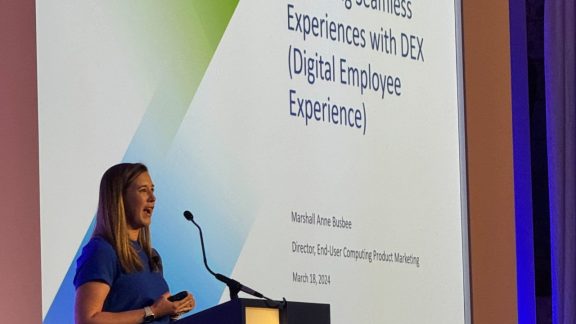By Ben Goodman, Lead Evangelist, VMware Horizon Application Manager
This is the 3rd blog in the series on the Consumerization of IT, it's effect and how it can be managed successfully. It will be followed by a whitepaper on this topic. Read the 1st blog and the 2nd blog.
There’s no shortage of news stories and blog posts lamenting the dangers associated with rogue devices and cloud services (I may have even contributed a couple).
They highlight compliance risks and ballooning costs. They explain how IT has lost visibility into many of the goings-on throughout the network. And, they often, perhaps too often, issue dire warnings about malware and other security risks. And, finally, they warn that, without the right steps being taken, quickly, there’s not much that enterprises can do about this consumerization of IT.
Unfortunately, while many times the fears are overdone, a lot of the points being made are quite valid – but they don’t tell the entire story. The full story is that there’s also a lot of good that can come out workers choosing their own devices and IT services and it’s an opportunity IT can’t afford to miss.
Let me explain.
Let’s step back to one of the oldest corporate services performed by IT one could imagine: file sharing and data back-up. A tremendous amount of work has been put into backing up corporate networks, but IDC tell us approximately 60 percent of corporate data is actually sitting on desktops, notebooks, and other endpoint devices, according to IDC. Then along came Dropbox. This service single-handedly provides people easy access to their data from anywhere and on most any device, simple tools for sharing files while also closing the endpoint data backup gap.
Dropbox is a perfect example of people organically turning to, and continuing to use, a service that fills a direct business need.
This has infuriated a fair share of CIOs and CISOs, especially if they read Dropbox’s Terms of Service. As a result, many organizations have tried to block Dropbox. We speak with thousands of organizations a year and we have found that this is not a successful approach. Most have actually failed, we’ve found. You can't take away from your workers something that's providing them a valid, needed business function. This doesn’t apply exclusively to Dropbox, but to any service that helps to make your users more agile, more mobile, or something that they believe helps them to better serve customers. You can't take that away. Not without lost productivity and resentment – and, eventually, not without a user revolt. The only way you can coax users away is by providing a competitive alternative. That’s the only way you can win.
Don’t think this is just about consumer-oriented services. It’s not. As the market dynamics evolve we’re seeing individuals, business units, and even enterprises deciding to leverage public cloud infrastructure services, collaborative suits, productivity software, communication platforms, CRM, and just about any software service imaginable. These services tend to penetrate the enterprise differently then traditional enterprise software. Take Salesforce.com, when it first came out, the service was priced in a way that individual sales reps could easily put it on their own credit cards and expense it without raising IT’s suspicions. Salespeople were willing to do this, because they benefited from the service, and many felt they were being underserved by big, heavy corporate CRM systems. Over time the service became indispensable and enterprise IT had to take notice. Today, companies are making strategic decisions to utilize Salesforce and other cloud based enterprise software, often in place of traditional on-premise ERP and CRM tools.
Organizations need to learn from these unilateral choices their employees and small business units are making.
Right there, in plain view, your people are showing you where internal IT is falling short and telegraphing where IT needs to go next. There’s a reason that they turned to Dropbox and Salesforce.com – because these services work and they address a specific business need in a way that their current services did not. That’s the important thing, in the long run, to keep in mind: although these services tend to de-prioritize things that are important to the enterprise, like security, compliance, and governance, they do tend to fit a specific business need very, very well.
Each time employees make a decision to choose a cloud service outside of the IT department, it’s an opportunity for IT to learn where those users are being underserved and to develop solutions that do fit the enterprise security, governance, and compliance requirements. So, in that sense, rogue services are a great opportunity for IT and they need to see it that way. Instead of looking at these service, tools and devices as unwanted invaders, IT needs to see them as what they are, leading indicators of their real customers’ needs.
We’ve all watched this happen with consumer services. For instance, a decade ago it looked as if no one was ever going to pay for music again. Everyone was pirating music from LimeWire, Napster, peer-to-peer networks, and wherever else.
Then iTunes arrived and proved that the issue was not peoples’ unwillingness to spend money for services they needed or the services they wanted: the issue was that people wanted immediate gratification. They wanted simplicity. People didn’t want to drive to the local Tower Records or Sam Goody, buy a plastic CD, and bring it home to have to rip it and copy it to their MP3 player. The real issue wasn’t cost, it was time and effort to value and Apple figured that out.
Today, too often, IT is doing just exactly that – expecting internal customers to drive down to the record store when cloud providers are making satisfaction just a mouse click away. So, if you see employees choosing the IT equivalent of Napster, look to see how IT can provide a viable alternative, the IT version of iTunes. Sometimes, IT can’t or doesn’t need to compete directly, with every cloud or consumerized product and in those times, vet the SaaS apps on the market and make sure you have the right tools to manage and secure them.
Learning from the times when employees select their own IT services, and adjusting accordingly, is one of the best ways IT departments are going to stay relevant in the months and years ahead.






